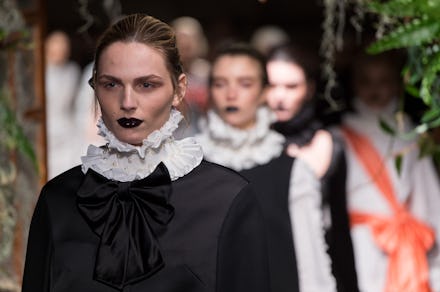Meet the Stunning Transgender Model Taking Over the Fashion Industry

"The prettiest boy in the world" is how New York magazine described Andreja Pejic in 2011. She went by "Andrej" then, and was known as a prominent "male model" whom designers featured in both men's and women's clothing.
Four years later, a lot has changed. Gender-confirmation surgery now allows Pejic to fully express her gender identity, and her career relies less on the novelty of her androgyny. And now this pretty face is making a big statement: Vogue reported Tuesday that the 23-year-old Australian will be the face of Make Up For Ever, making her one of the first transgender models to land a major beauty campaign.
Pejic's prominence, along with the heightened visibility of several transgender people in politics or entertainment, exemplifies growing mainstream acceptance of trans identity. In a small but important step, President Barack Obama became the first U.S. president to publicly use the term "transgender" in his State of the Union Address in January. Laverne Cox appeared on the cover of Time magazine last May, and the bourgeoning conversation around equal rights — from health care coverage to restroom access — is bringing trans issues front and center.
But challenges persist. Trans women — especially women of color — face what the Human Rights Campaign calls "a national crisis" of antitrans bigotry and violence. As of March, at least seven trans women had been murdered in the U.S., all but one of whom were black or Latina.
A 2011 report from the National Coalition of Anti-Violence Programs adds that trans people were 28% more likely to face physical violence than their gender normative peers.
Pejic's experience is inevitably informed by her perception as a conventionally beautiful white woman, but she's also no stranger to hard times. Born in what is now Bosnia-Herzegovina shortly before the start of the Bosnian War, Pejic escaped as a child to a refugee camp outside Belgrade, Serbia with her mother, grandmother and brother. They lived in Serbia for years before emigrating to Melbourne in 1999, according to Vogue.
Modeling was Pejic's refuge in Australia. Where her school experience was marked by attempts to hide her "feminine styles of speech, gait and gesture" in order to avoid bullying, Vogue writes that the similarly proportioned female models she was surrounded by at work made her feel at home.
The space Pejic and her transgender peers are creating in the fashion industry today aspires to mirror that feeling, and to make a statement. "It is about showing that this is not just a gimmick," she told Vogue. Along with contemporaries like Lea T, Arisce Wanzer, Ines Rau and others, Pejic is proving that traditional notions of gender and beauty are rapidly being subsumed by a growing transgender movement. It's a far cry from where we need to be as a culture — but any step that promotes the widespread acceptance of trans people is a step in the right direction.